Why We Should Stop Asking “Does This Spark Joy?” – My Aha Moment.
You may have been living under a rock if you haven’t heard of Marie Kondo. She’s the cute, petite woman who’s been popping into people’s cluttered, messy homes for the past month on Netflix (longer, if you’ve read her book, The Magic of Tidying Up) encouraging people to ask, “Does this spark joy?” before deciding whether or not something is worth keeping or getting rid of.
My readers and I who just finished up our 30-Day “Junk-Free January” Room Makeover Challenge have been asking ourselves this question a lot lately (which is why you may not have seen new projects from me recently–I’ve been too busy re-doing my basement. You’ll see our room makeover reveals later this week!). As we sorted through piles of junk, unused craft materials, and “someday” DIY projects, we attempted to get rid of things that no longer made us “happy” or “sparked joy.”
During the challenge, a poignant blog post was published from The Guardian criticizing Marie Condo’s advice and beliefs. Gasp!! Criticizing?? Who could ever think that tidying up your home was a negative thing?? However, the author points out that this method of just getting rid of things that don’t spark joy anymore means that discarded items ultimately end up in landfills (yep–even if you donated it, it may very well be trashed by the thrift store since they only sell a portion of what is donated) and third world countries. The resources used to produce it get wasted, too–the water, the energy, the labor, etc.; all the things we don’t seem to think about as consumers.
Essentially, the author of the article claimed we’re promoting a “disposable” culture if we simply get rid of things that no longer make us happy. The solution, she claims, is to stop buying so much stuff, not getting rid of things.
I read the article and thought, “Yeah, I can see her point…but I still can’t have all this unused clutter sitting around! It’s got to go somewhere!”
If you don’t believe me, look at what I was up against in my basement office for our January Room Makeover challenge: messy, cluttered, and in my opinion, an excess of stuff.
BEFORE
Some of it just needed better organization. But there were clearly pieces that needed to go because they “no longer sparked joy” for me.
BEFORE
What you may not notice is that little red mid-century modern table amongst the clutter. It’s the very first piece of furniture I bought back in 2002 after buying my first condo. I bought it from one of my favorite thrift stores for a mere $6.00. I remember spray painting the brown laminate top a brilliant red, proud to have found such a gem. While I was very proud of the piece, it never seemed to quite “go” with anything in my house the last 10 years of the 17 years I owned it.
But it was time to let it go. After all, Marie said that if it doesn’t spark joy, just let it go. Despite its sentimental value. Despite how cool it was. Despite the memories of my middle son, at the age of 2, climbing up on it and falling off, landing in Urgent Care with 2 stitches to his ear. Despite all the coolness, the memories, and the perceived value of a mid-century modern table like that, I was prepared to let it go because it didn’t pass the test of, “Does this spark joy?”
My husband has a way of sifting through my “DONATION” piles to see what he can salvage. As much as he complains about me bringing too many things home, he is also quick to complain when perfectly good things are given away (which makes decluttering difficult at times!). Well, he peered through my donation piles to see the little red table about to go to the thrift store. He pulled it out, took it upstairs to the family room, and placed it in some random corner of the room, advising me to, “Just keep it. You never know when you might need a table to set some drinks on.”
Fast forward a couple weeks later to the end of the room makeover challenge and my basement was coming along, looking cozy, clean, and decluttered. I realized that I needed a side table for the love seat and chair seating area I had created after all that clutter was removed. It didn’t make sense to go and buy another one, so I lugged that little red table back to the basement, slapped a new complimentary coat of paint on top to go with my new color scheme (and I’ll admit–a new lamp from Target), and what do you know–it sparked joy again!
AFTER!
I shouldn’t be shocked at this concept of making something new again. After all, that’s what I do here at Thrift Diving. The uglier, the better is my motto. Decorating your home on a budget and reusing what you can was the basis of how this blog started. But even I am a victim of consumerism. Just because I tend to go thrift diving for many of my furniture items, doesn’t mean my consumerism is better than the next person. What matters is that I was going to buy something else that sparked more joy; something that “matched better” to my basement office for the room makeover I was doing. I was going to discard something because just because it didn’t spark joy anymore. And that, my friend, was the wrong thing to do.
Just imagine how many pieces of furniture that someone discarded because it no longer sparked joy for them…pieces that I picked up from the thrift store and made them look amazing again. Do you think if the donators had imagined their piece of furniture could spark joy again that they would have given it up? Maybe not.
….like this $10 French Provincial vanity from the thrift store that I made over…
….or this $30 mid-century modern dresser that I stripped and refinished!…
One of my readers pointed out something great: it’s not about asking, “Does this spark joy?” but rather, “How can I reclaim the joy?”
I’d like to take that question even further with these questions:
- “If I paint or stain this a different color, would this spark joy again?”
- “Could I use this in another part of my house?”
- “Could I repurpose this into something else?” (Read this article to get some creative ideas!).
- “Would this spark joy for a friend or family member instead?”
- “Could I sell this to someone?”
- “Could I list this item for FREE online?”
If we ask ourselves these more detailed questions instead of just asking, “Does this spark joy?” then we could save ourselves a lot of money (by reusing what we have)…do more for the planet (which prevents overfilling landfills)…and making more mindful purchases from the beginning!
I’ll admit that even as much as I love making things over, asking myself these questions won’t stop me from ever making another purchase again. And it won’t stop me from donating to my favorite thrift store (which does help the communities the thrift store supports). But it does make me pause to think about each purchase and whether I really need to bring that home with me or if I can reuse something that’s already in my home.
The author of that article is right: if we just learn to buy less stuff anyhow, maybe we wouldn’t even have to declutter and ask ourselves, “Does this spark joy?”
Enjoyed this article? Save it on Pinterest!
Be sure to SUBSCRIBE so you don’t miss the next post!
And if you enjoyed this article, check out popular furniture makeovers:
- $10 French Provincial Vanity Makeover from the Thrift Store
- Mid Century Modern Dresser Makeover Stripped and Refinished
- Eat-in Kitchen Table Makeover: BEFORE & AFTER
Download the 5 freebies!

Thrift Diving inspires women to decorate, improve, and maintain their home themselves...using paint, power tools, and thrift stores! Use these 5 printables, checklists, and ebooks to get started!

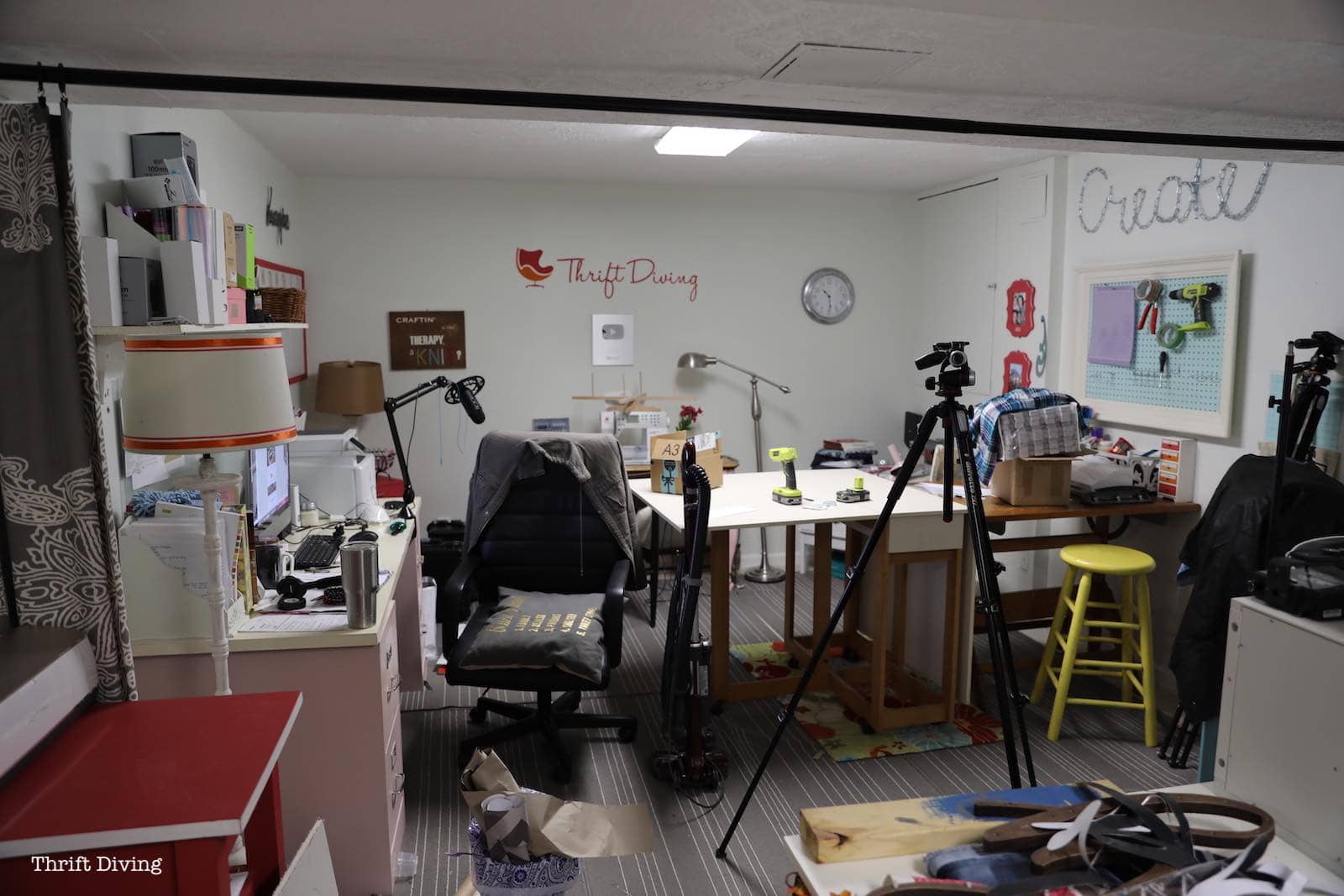
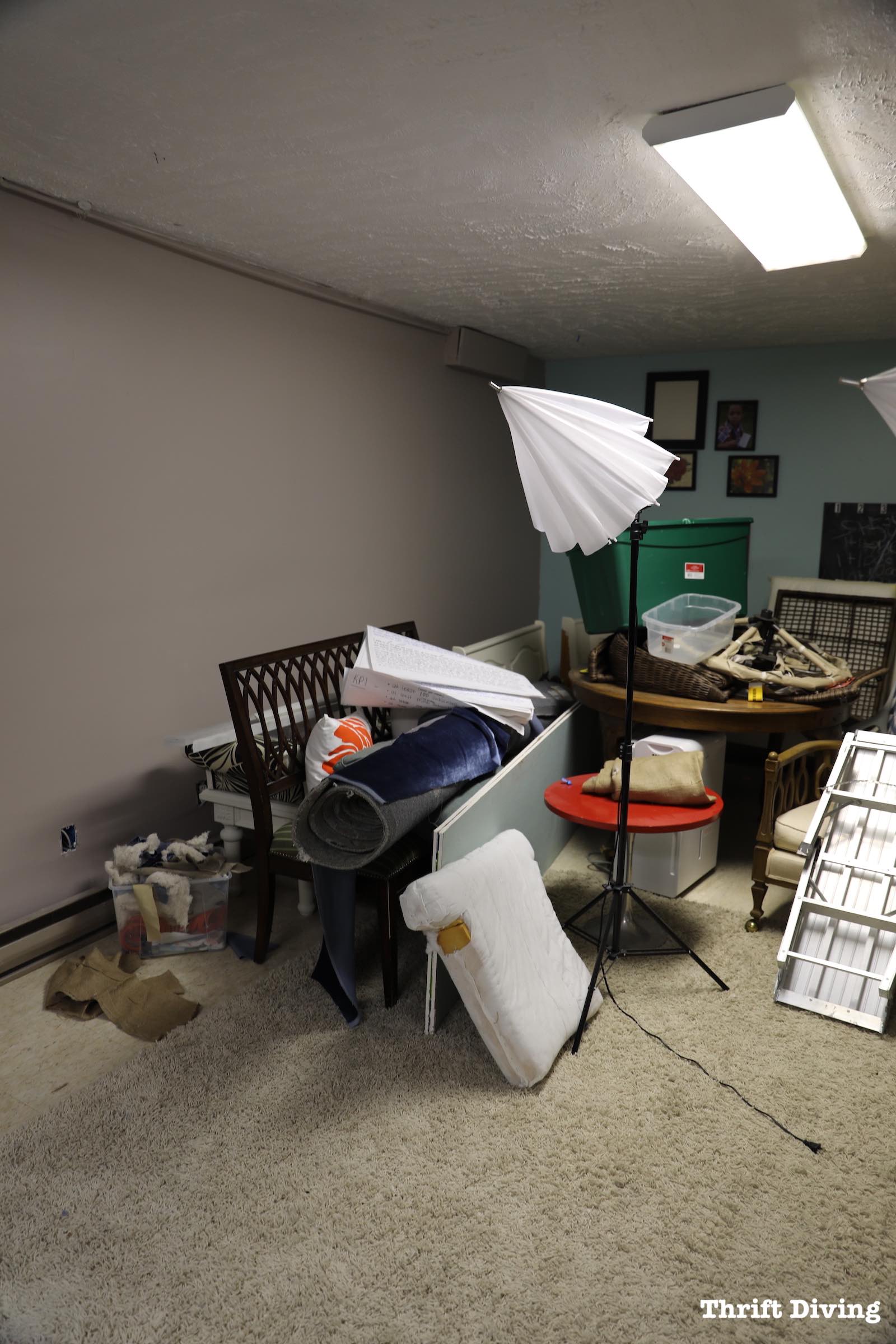
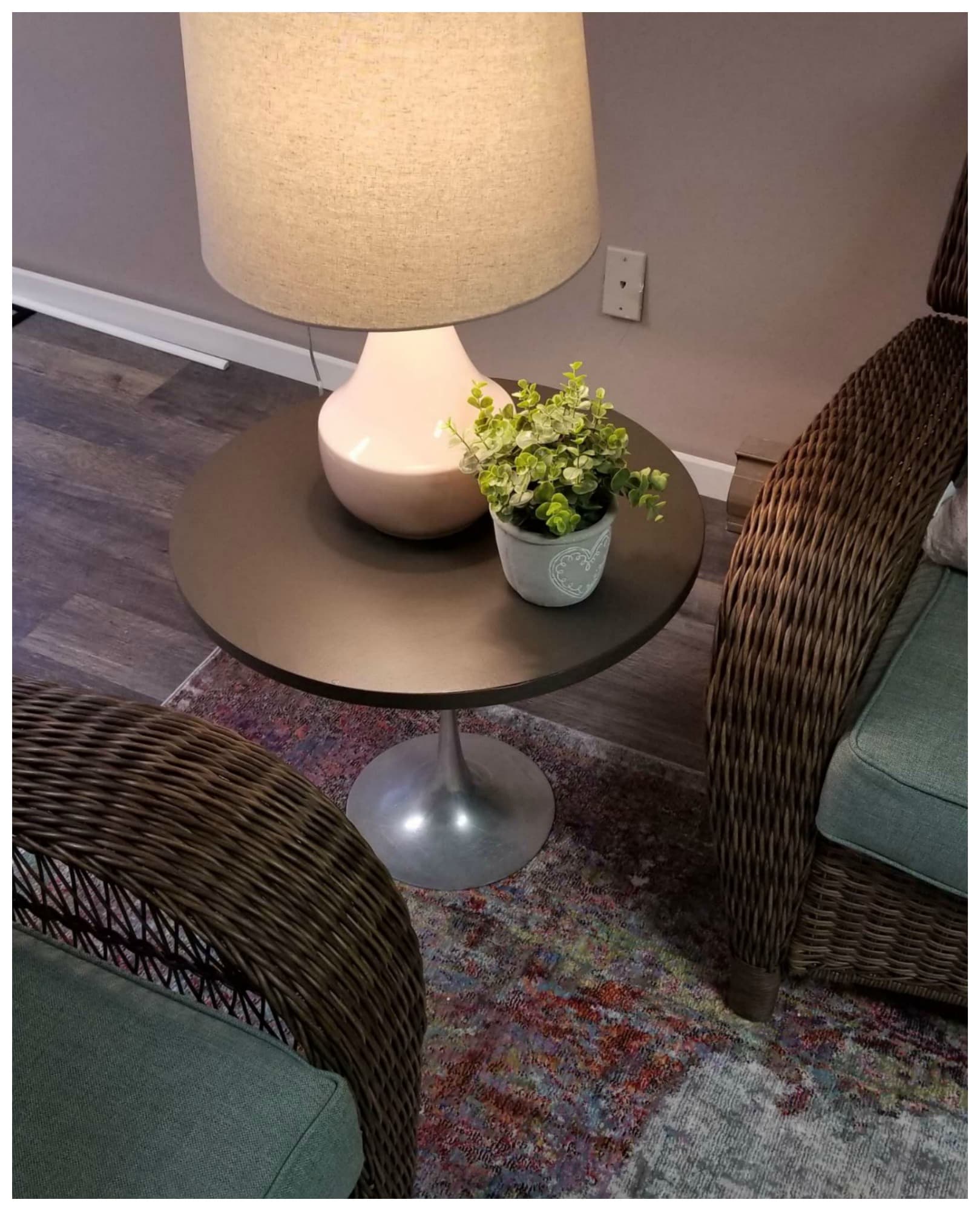
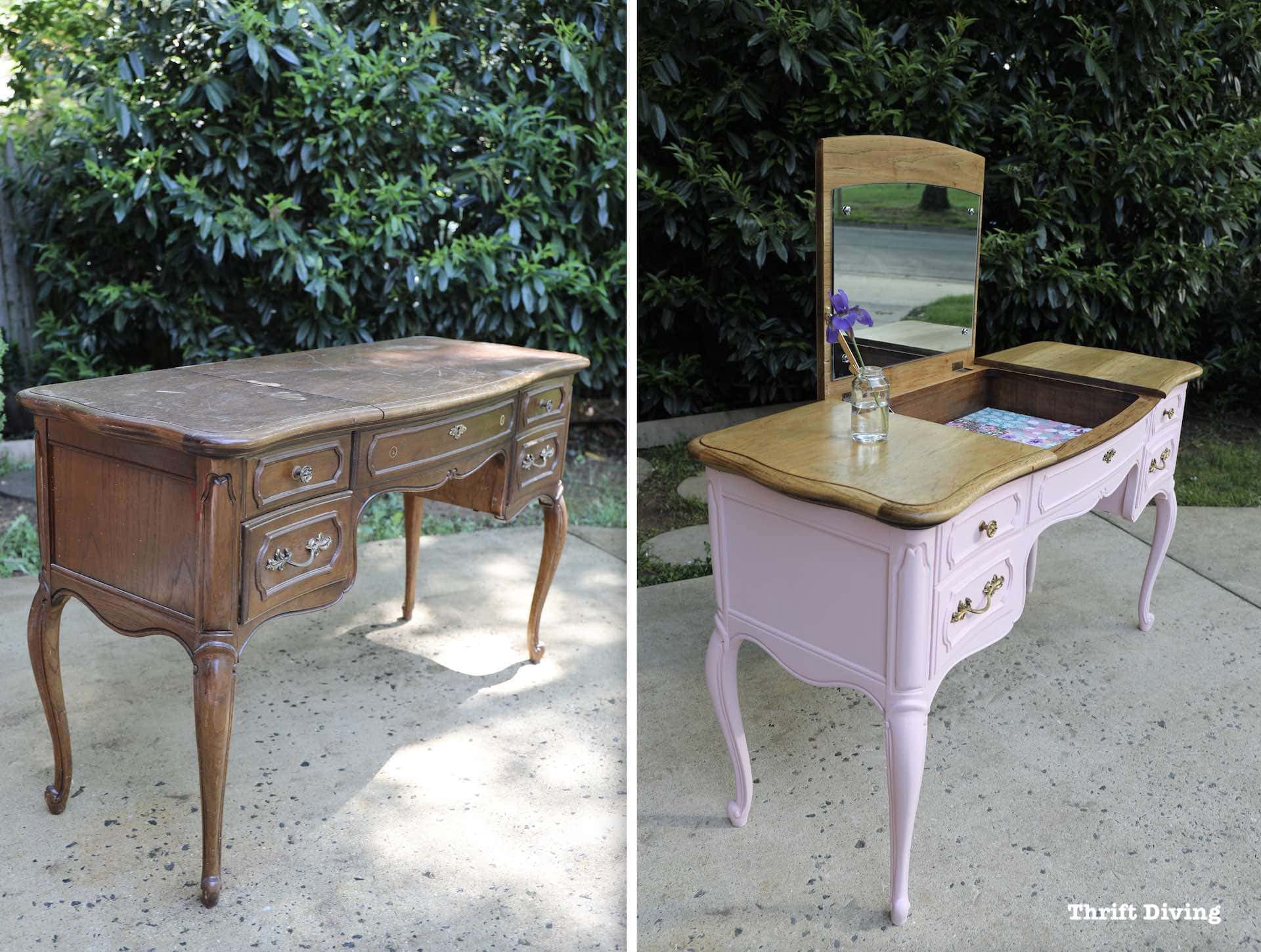
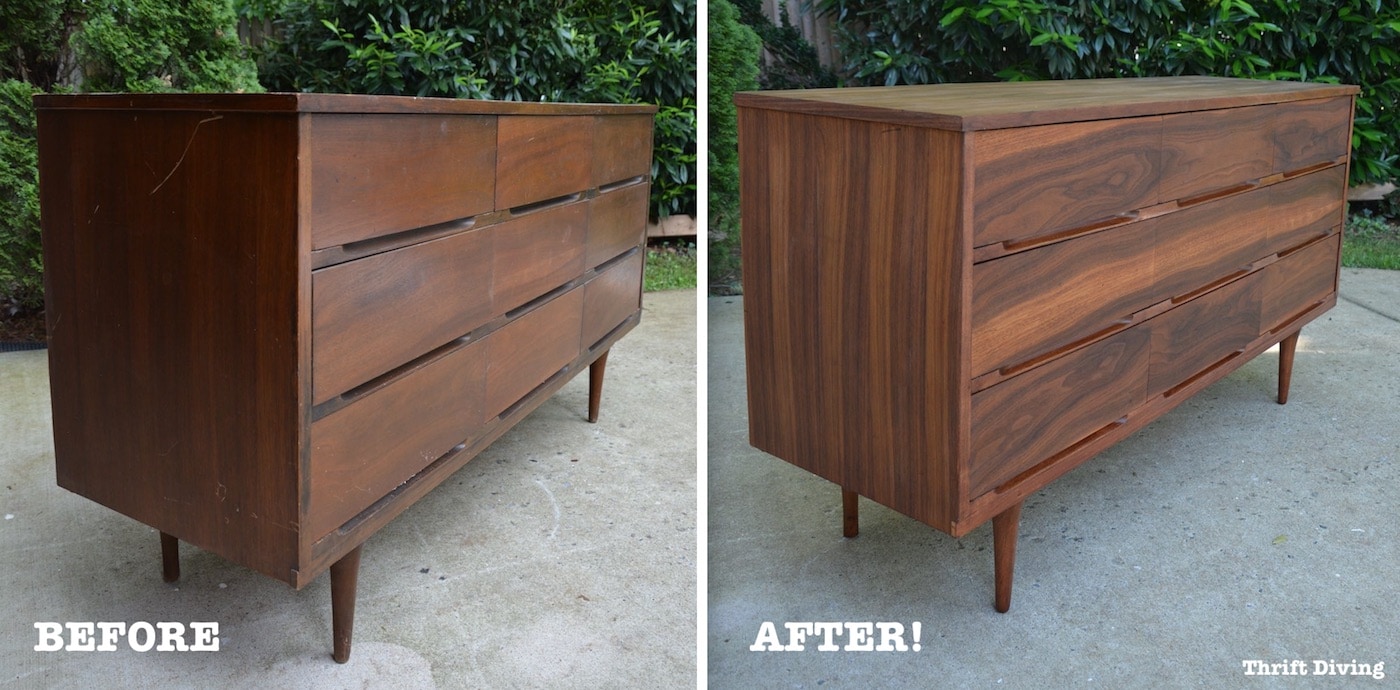







Outstanding as always! 💓
Hi Serena,
Thank you for inspiring me/us with every blog and video you post. One of my favourite stores is the dollar store. Last week I wrote down the seven items that I thought I wanted. When I got home, I decided that I only needed two of these items and returned the next day to purchase them. When I got home, I washed them and put them to use right away and have been happy ever since that I did not buy the other items. Not only did I save money, but I did not add more clutter to my house which would some day clutter our landfill sites. Another technique that I have used to decide whether or not to purchase an item, is an idea from my smart daughter. She said to take a photo of an item if I am not sure about purchasing it and then think about it.
I’m learning how to not make that impulsive buy at a thrift store when I see something I like. I will put it in my cart, walk around with it and think about how I can use it, where I would put it, look at it from time to time, and then ask myself if I Need it. If I can say I really don’t need this, I end up putting it back on the shelf. As for things I already have that are taking up storage space but I refuse to part with, I’m learning to rotate them by switching them out for decor I’m tired of looking at, That way my rooms are refreshed with something “new” that’s actually been around awhile and I can enjoy it all over again. If I’m truly sick and tired of it, and I suppose that would be the “does it spark joy’ part, then I can let it go without a second thought. Years ago when I first started collecting and thrifting items, I never had a process for buying and letting go, now I do and it really feels good!
I agree with you rather than ask after the purchase does this bring me joy, maybe we need to take the time before buying and ask, Do I really need this? or If I buy this, what do I need to get rid of before buying this? Thinking long term before buying and not just shopping for the sake of just buying stuff. This is true for not only furniture but clothes, jewelry, shoes, etc. Most of us are impulse buyers we buy just to because it is pretty it looks nice, or “she has one so I want one. Be mindful when making purchases.
Right, Diane! I know I have bought things just because I was getting a deal–things that took up space, cost me money, and was very wasteful, just because I was getting it for a fraction of what it cost at retail. NOT a good reason to buy something. I am starting to think about the “end of life” for items I bring into the home. For example, I just sold a pool table that I bought into the house about 4 years ago, thinking I was going to use it. I didn’t. 🙁 Not really. And it ended up being a heavy burden. I told hubby, “If I ever want to bring something huge and bulky into the house again, remind me of this pool table situation…” LOL!
There is so much hype about decluttering and the pros and con over the Kondo “Joy” method but hey…she’s making a fortune! Wish I had thought to write the book–or any book for that matter! My parents grew up during the depression and a lot of my mother’s beliefs have been round into my decisions of keeping or tossing. I have started painting furniture and keep every plastic container that we empty….they are so good for storing mixed paint. However, I will soon have to stop collecting these containers and that is ok too. Rationalization is one of the ways we justify our actions so if you have to be accountable for your clutter, then come up with a good reason. If you can’t think of anything, it may be time to let go!
Oh, she is cleaning UP! I still like Marie Condo. After all, my drawers have become SO much more organized because of her for the past few years since reading her book. She is helping millions of people. I just hope that most of us can think longer about what we bring in and what we ultimately give away. Thanks for commenting!
Great blog post! I thought your point of view was spot on, and its how I would go about de-cluttering too. In fact, I must get on with that!
Hey, Suzy! 🙂 Thank you, I’m glad you enjoyed it!
Marie Kondo really helped me get control of the clutter in my small house. She made me realize, that it is not just about buying more storage containers , or the “right” storage container, but that you actually have to get rid of stuff!!!! Many of us do not have time or energy to hang on to things and “re-make” them. We have good intentions to, but weeks slip into months and months slip into years and the projects never get done due to poor health, work schedules, jobs, or sickly parents or pets or kids we have to take care of, etc. This makes a huge collection of clutter we are afraid to part with. Or feel guilty parting with. Marie Kondo gives us permission to get rid of it. I recently used “Free Cycle” in my area to give some of my items to people happy to take it away. The rest I give to Good Will, or the metal scrap man in my area who hauls away metal objects. It is the way he makes money by selling them to the scrap yard.
And while the question, “Does this spark joy” can be helpful, I don’t think Marie meant for this to be the only guideline, but rather a starting point.
Laura Whitman from Clutter Re-Hab says that if you are having trouble letting go of people or clutter eating up your space or time, think about what it requires you to sacrifice. That helped me let go of many “some day” projects that just took up space and prevented my house from being neat and clean. I had to get honest and realize I was never going to have time to sew all my own curtains, or make a new handle for that old purse, or re-upholster that chair, etc. I was sacrificing my dream of a clutter free home for these projects I was going to get around to “someday”.
Sometimes you just have to let go of stuff.
LOVE this! I think you hit the nail on the head with Marie meaning for the “spark joy” question to be a starting point. I like to think of it like this: “Does this spark joy?” If YES, keep. If no, then ask the following questions: “HOW can I make this spark joy again?” And keep going from there. But you’re right–you have to let go, but we have to learn the lesson so that next time, instead of letting go once it’s in our house, we make better decisions about which things we bring home, which projects we start, etc. Thanks for your thoughtful comment! 🙂
Yes , so well said. We have to learn from our mistakes and be more mindful with what we bring in.
I have an old comfy air chair in my bedroom, that has been my safe haven on many sleepless nights when I was sick with one thing or another. After re-painting our bedroom, the chair, although still comfortable looked tattered and worn. I washed it with an upholstery cleaner but that didn’t do much. Then I found an in expensive white slip cover online and it is shocking how much better it looks. It isn’t always necessary to buy new to have good (or at least improved) design. I also want to tell you I loved your “colorful” bathroom with the blue cabinet and stenciled wall. It is still one of the best bathrooms I’ve ever seen.
oops! Meant “chair”….not air chair…
Hello, I think the Kondo method is a great starting point for many people because we often just have too much stuff. We get caught up in our stuff and can’t move forward. When we buy something we have a purpose for our current taste and lives, bu then over time our lives and tastes change. I agree with Elisabeth it is a great place to start but allow for it to be amended as needed for you and your life. Besides, even if you think that something would be great for someone else, there is no guarentee they will like or want it or that you will even remember that you wanted to tell someone about it (this is my problem, thoughts go as fast as they come)…..so it still sitting somewhere in your home. Whatever method you use I think it’s safe to say that NOONE really wants to live with a house full of stuff you don’t want or need any more. Asking the question may help push it out the door. Also as the old saying goes, “Everything isn’t for everyone” and that’s ok. Thanks for the post.
Yashika, great points! It’s sooo easy to acquire a bunch of stuff. Especially people that love thrift stores because there is so much good stuff there! LOL
I like your questions much better, Serena! Loved the blog and congrats on the reorg! I’m looking forward to seeing all of the befores and afters!
They’re coming, Donna! I’m putting everything into the editing software as we speak and will spend some time putting the finishing touches tomorrow. Hopefully, it will be ready early this week. You will LOVE them!!
Great blog post!
I’ll say I used her method throughout my 30 day challenge, and it helped so much in changing my perspective on new purchases I make. I was always somewhat of an impulse buyer. However now before I buy, I ask myself if it really sparks joy. It helps me put a lot back on shelves that I would have otherwise bought.
I think the konmari method is a good template to follow, but as all templates, they can be amended. We are a group of people who have an eye to help previously unwanted items recover their joy!
Just like you said aha!!!! I will use your advice moving forward. Thanks,. Jeryl
Elizabeth, yes!! I just had another “aha” moment! Maybe “Does it spark joy” should be what’s asked BEFORE WE BRING IT HOME (like you did during our 30-day room makeover challenge), and then the other questions are what we ask after it’s home and we’re considering getting rid of it! 🙂 YAY! I like that model. Thanks for the inspiration on that! 🙂